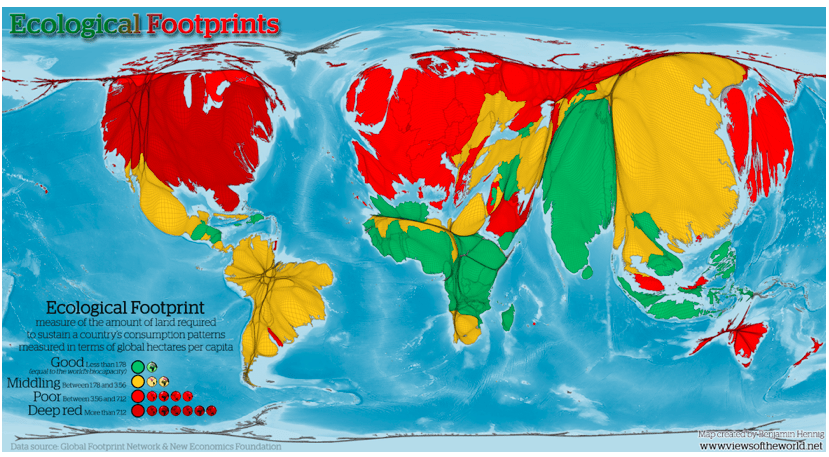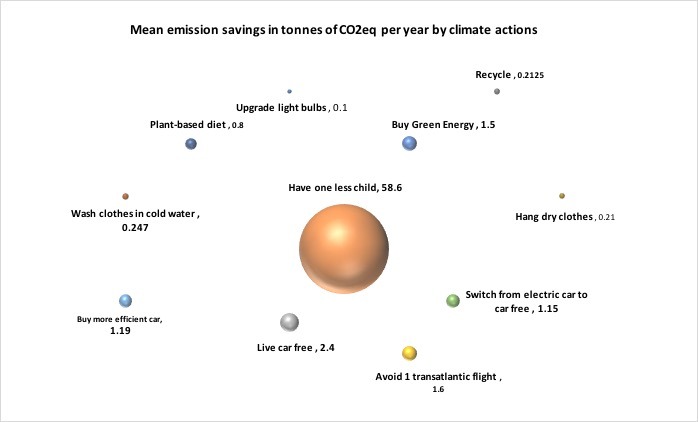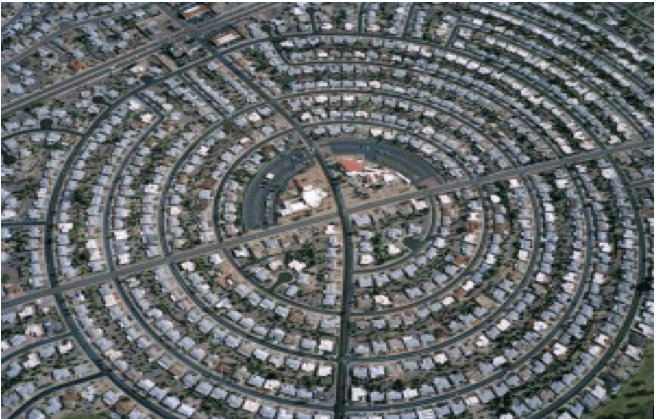We are now experiencing unsustainability at all levels, ranging from deforestation, habitat destruction, species extinction, atmospheric and marine pollution to climate change. Yet most efforts to mitigate environmental degradation focus only on consumption and technology, which are still too slow and insufficient to have the required effect. This article therefore highlights the link between resource consumption and population (the latter virtually having dropped from the IPAT formula in the mainstream environmental debate). It argues that population is not only a crucial factor to be addressed in developing countries but also in developed countries since the environmental impacts of having additional offspring are disproportionate.
The proportion distortion
Most countries use more resources than their biocapacities can renew, resulting in ecological deficits that have become self-evident in overharvesting, overfishing and accumulating carbon dioxide emissions. This is possible because high-income countries can afford to import other nations’ biocapacity in the form of goods and services[1], leading to disproportional effects on the environment.

Populous and voracious
Since most high-income countries have fertility rates at or below replacement level, their population numbers are widely considered irrelevant in the environmental debate. This is a mistake, because those born in high-income countries consume more resources and cause much higher greenhouse gas (GHG) emissions than those in developing countries. In the UK for example, the 1.6m new births expected by 2026 will consume as many resources as 8 million Kenyans. And this does not include the impacts from the 1.9m people from international immigration[2] and the knock-on effect from second-generation mothers with culturally higher birth rates[3].
Moreover, birth rates in Europe have recently rebounded to 1.6 births per woman[4], with 13 per cent of European mothers having more than two children[5]. Meanwhile, the US is among the nine countries in which half of the world’s population growth is expected until 2050[6]. The US also has millions of women with unmet family planning needs and multiple barriers to contraception[7]. Similar to the UK, three-fold motherhood is becoming increasingly fashionable, especially among affluent, highly-educated women[8],[9]. This does not bode well for the planet.
The elephant in the room
While there is much knowledge on how to reduce consumption and GHG emissions, little attention is being paid to the population-side of the equation – despite the fact that the world population is expected to rise to 11.2 billion people by 2100[10]. Part of the problem is that many see poverty alleviation, education and gender equality as silver bullets that will reduce population levels without further intervention[11].
Certainly, world population growth rates have slowed, but the world’s 47 poorest countries still have an average 4.3 births per woman. The combined population of these countries is set to increase to 1.9 billion by 2050, with 26 African countries doubling by 2050[12]. As well as tackling poverty, education and women’s rights, it is surely essential to promote the need for smaller families across the world.
The monster we created
We are trapped in highly complex, self-organizing and self-serving social and economic systems that limit our ability to predict and manage the future[13]. Despite international agreements and many good intentions, the effects of unsustainability are being felt everywhere, from localized deforestation and atmospheric pollution to global warming. How much time is left before ecosystems collapse and the devastating effects from climate change are unleashed?[14]. Such effects are unequal, leading to increased risks of civil conflicts and mass migration[15],[16].
Moreover, humans have now changed most of the earth’s land mass[17]. And we have also wiped out 83 per cent of wild mammals and replaced them with livestock and more humans[18]. These are deeply worrying trends.
Your gift to the world
The challenges ahead are huge. To build a more sustainable world, the institutional, political and corporate lock-ins need to be weakened[19]. But this is also an extremely hard, long-term process and for decades we have only been tinkering around the edges. Behavioral shifts, given the will, can happen more quickly and be adopted more widely.
It is difficult to see how sustainability can be achieved without addressing population as well as consumption. To reduce consumption, we also need fewer consumers. Yet voluntary family planning is barely mentioned in the climate change debate, and the link between population and the environment is not taught in schools[20]. Recent studies have calculated that having one child less in a high-income country is the biggest positive contribution an individual can make to the planet, saving a staggering 59 tons of GHGs alone per year – 25 times more beneficial than living car-free, or 70 times more than becoming a vegan[21],[22].

It is therefore important to inform and educate people on how family size impacts on the environment. Having one child less may be easier for some than living car-free or avoiding air travel.
Actions not words
So why is population such a controversial issue? Perhaps because of the widespread myth that stabilizing population numbers is intrinsically coercive. This prevents a rational discussion about the subject[23] and also disregards the ability of individuals to improve their world.
To keep global warming below 2°C, today’s children will be faced with cutting their own GHG emissions by 80 per cent by 2050[24]. They will have to sort out the mess we created.
Unfair, yes. But how fair is it for high-income nations to expect the poor nations to reduce their populations to mitigate climate change when their own numbers and emissions have been allowed to soar at a time when their actions on climate change have been insufficient?
And how fair is it for high-income nations to obliterate the livelihoods of the poorer ones, let alone pushing other species to extinction?
And what if the Paris Agreement with its promised carbon cuts amounts to too little, too late– and we find that we have put all eggs in one basket without considering the whole range of mitigation options?
And why not consider that whilst the freedom to reproduce is a fundamental human right, responsible societies can protect and limit that right? Running a business is also a fundamental right but this is regulated because of the high external costs involved, such as climate change and pollution. Environmental taxes deter harmful activities by making them costlier; the revenues are then redistributed to protect the environment. Reproduction also puts high external costs on the planet. Should we not incentivize people who keep their reproduction at or below replacement level, rather than those who choose to have more offspring?
And why not estimate science-based, sustainable human population levels, as demanded by thousands of scientists?[25]
The bleak reality of our world’s environmental and social state is staring us in the face. Solving these issues will require enormous shifts in technology, society, and behavior. It also includes having level-headed discussions about population as a key factor in environmental and social destruction, and one we cannot afford to omit.
Dr. Sibylle Frey MSc BSc is an environmental scientist and nutrition specialist who has worked in sustainable consumption and production, including ecological footprint modelling, carbon footprint assessments, life cycle assessments and sustainable nutrition approaches. She has also been peer reviewer for the Journal of Industrial Ecology. She can be contacted at hello@drsibylle.com
The MAHB Blog is a venture of the Millennium Alliance for Humanity and the Biosphere. Questions should be directed to joan@mahbonline.org
[1] http://data.footprintnetwork.org/#/
[2]https://www.ons.gov.uk/peoplepopulationandcommunity/populationandmigration/populationprojections/bulletins/nationalpopulationprojections/2016basedstatisticalbulletin#changes-since-the-2014-based-projections.
[3]https://www.telegraph.co.uk/news/uknews/immigration/10927865/UK-has-had-fastest-growing-population-in-Europe-for-a-decade-official-figures.html
[4] https://ec.europa.eu/eurostat/statistics-explained/index.php/Fertility_statistics
[5]https://ec.europa.eu/eurostat/web/products-eurostat-news/-/EDN-20170531-1
[6] https://www.un.org/development/desa/publications/world-population-prospects-the-2017-revision.html
[7] BMJ 2016;353:i2102 http://dx.doi.org/10.1136/bmj.i2102
[8]http://www.pewresearch.org/fact-tank/2018/08/09/middle-children-have-become-rarer-but-a-growing-share-of-americans-now-say-three-or-more-kids-are-ideal/
[9]https://www.telegraph.co.uk/news/uknews/immigration/11806379/End-of-2.4-children-as-Britain-has-biggest-families-in-Europe.html
[10] https://www.un.org/development/desa/publications/world-population-prospects-the-2017-revision.html
[11] For example, Hans Rosling; https://www.bbc.co.uk/news/magazine-24835822
[12] https://www.un.org/development/desa/publications/world-population-prospects-the-2017-revision.html
[13]A.H. Sorman and M. Giampietro, 2013. The energetic metabolism of societies and the degrowth paradigm: analyzing biophysical constraints and realities. Journal of Cleaner Production 38 (2013) 80e93
[14] WWF 2016. Living Planet Report 2016. Risk and resilience in a new era. WWF International, Gland, Switzerland.
[15]https://www.technologyreview.com/s/544616/hot-and-violent/
[16] http://www.csap.cam.ac.uk/media/uploads/files/1/climate-change–a-risk-assessment-policy-brief-v3.pdf
[17] WWF 2016. Living Planet Report 2016. Risk and resilience in a new era. WWF International, Gland, Switzerland.
[18] Bar-On et al. 2018. The biomass distribution on Earth. PNAS June 19, 2018 115 (25) 6506-6511
[19] WWF 2016. Living Planet Report 2016. Risk and resilience in a new era. WWF International, Gland, Switzerland.
[20] S. Wynes and K. A. Nicholas, 2017. The climate mitigation gap: education and government recommendations miss the most effective individual actions. Environ. Res. Lett. 12 074024
[21] S. Wynes and K. A. Nicholas, 2017. The climate mitigation gap: education and government recommendations miss the most effective individual actions. Environ. Res. Lett. 12 074024
[22] P.A. Murtaugh, M.G. Schlax, 2009. Reproduction and the carbon legacies of individuals. Global Environmental Change 19 (2009) 14–20
[23] BMJ 1999;319:933
[24] B. Girod et al, 2014. Global climate targets and future consumption level: an evaluation of the required GHG intensity. Environ. Res. Lett. 8 (2013) 014016
[25] William J. Ripple et al. (2017). World Scientists’ Warning to Humanity: A Second Notice BioScience, Volume 67, Issue 12, 1 December 2017, 1026–1028
The views and opinions expressed through the MAHB Website are those of the contributing authors and do not necessarily reflect an official position of the MAHB. The MAHB aims to share a range of perspectives and welcomes the discussions that they prompt.
